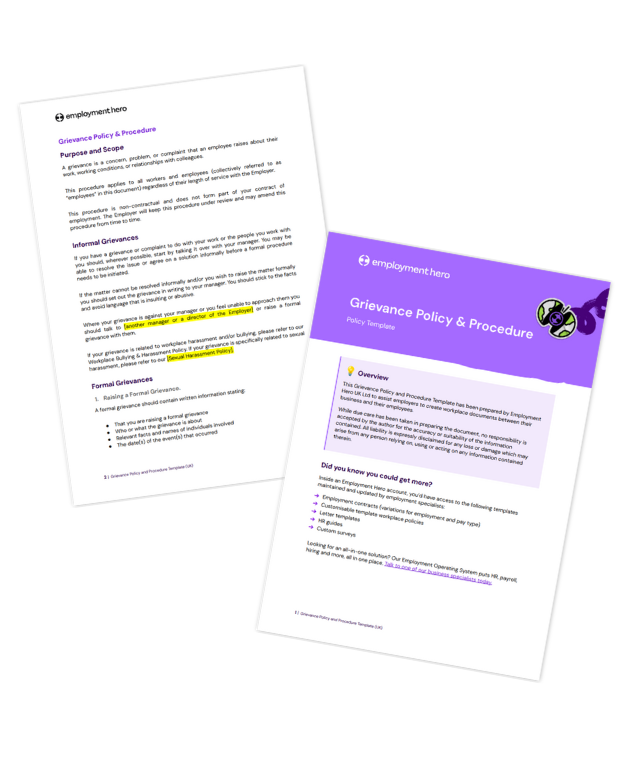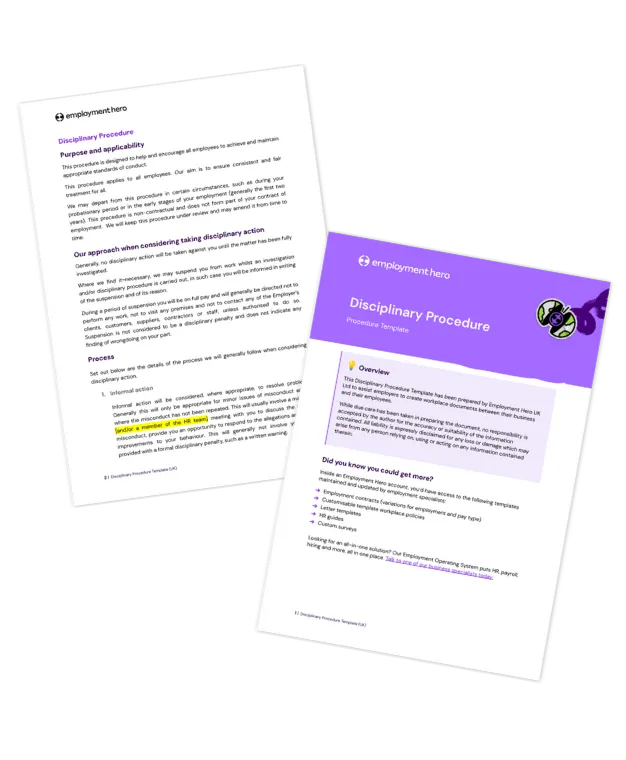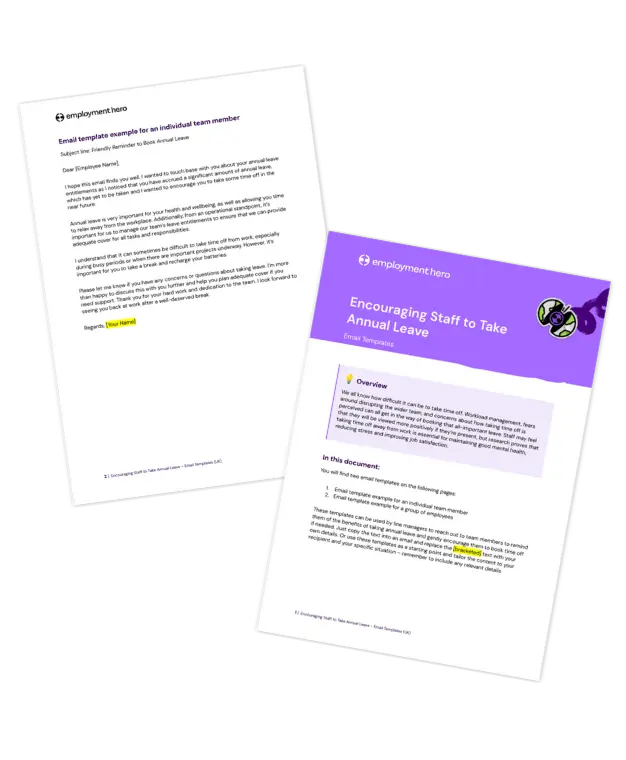Salary reduction agreement letter template and guide
Published
Salary reduction agreement letter template and guide
Navigating economic uncertainty can be challenging. Whether your business is restructuring, facing financial pressures or responding to market changes, our downloadable salary reduction letter template and this guide will help you navigate the process, tighten your understanding of the consultation process and protect both your people and your business.
What is a salary reduction letter?
A salary reduction letter is a mutual, written agreement between an employer and an employee to reduce the employee’s pay. In the UK, this could be a temporary measure during a downturn, a permanent change due to role adjustments or even a change requested by the employee (for example, moving to part-time work).
The agreement should clearly outline the original pay rate, the new pay rate, the reason for the change and whether it is temporary or permanent. It must be signed by both parties to be legally binding.
Is it legal to reduce an employee’s salary in the UK?
A reduction of salary is lawful, but only with the employee’s consent and in line with UK employment compliance. Under the Employment Rights Act 1996, a change to pay is a contractual change.
Without written agreement, a salary reduction could be considered an unlawful deduction from wages and may also give rise to claims for constructive dismissal if the employee feels forced to resign. In extreme cases, mishandling the process could lead to unfair dismissal claims.
Employers must:
- Follow a fair consultation process, giving employees time to understand and consider the proposal.
- Gain written agreement before the change takes effect.
- Where applicable, involve recognised trade unions in negotiations.
- Follow ACAS guidelines to minimise the risk of legal disputes.
Common reasons for salary reduction
Salary reductions may be used in scenarios such as:
- Voluntary request: An employee requests reduced hours or responsibilities.
- Demotion: A change in role to a lower-level position.
- Business downturn: A pay cut might be an alternative to redundancies, allowing businesses to retain staff while reducing costs.
- Performance issues: Pay adjustments as part of a fair performance management process.
How to use a salary reduction letter
If you’re considering reducing an employee’s pay, it’s important to approach the process fairly and compliantly. Salary changes affect not only the employee’s finances but also their morale and trust in the business.
A well structured and compliance-led approach will help you reduce the risk of disputes, avoid claims for unlawful deduction, constructive dismissal or unfair dismissal, and maintain a positive working relationship. Here’s what to keep in mind:
- Determine if it’s appropriate: Have a clear, evidence-backed reason (economic need, structural change, etc.).
- Follow a consultation process: Meet with affected employees and, if relevant, trade union representatives.
- Secure written agreement: Never alter a pay rate without signed consent.
- Update the employment contract: Reflect changes to pay and related terms.
- Provide notice: Respect statutory or contractual notice periods.
- Check minimum wage compliance: Confirm the new pay meets or exceeds the National Minimum Wage or National Living Wage.
What to include in a salary reduction agreement
Your salary reduction agreement should include all the essential details to make the change clear and legally sound. This means outlining the names and roles of both parties, stating the original salary alongside the new reduced pay rate, and specifying the effective date and whether the change is temporary or permanent.
It should clearly explain the reason for the reduction, confirm that the employee has given their consent, and detail any impact on pensions, holiday entitlement, bonuses, or other benefits. If you’re crafting an agreement from scratch, be sure to include:
- Names of both parties and their roles.
- Original salary and new reduced pay rate.
- Effective date and whether the change is temporary or permanent.
- Reason for the reduction.
- Confirmation of the employee’s consent.
- Details on the impact to pensions, holiday entitlement, bonuses, and other benefits.
- Signature fields for both employer and employee.
Legal and compliance considerations
Navigating the legal side of a salary reduction is just as important as managing the conversation with your employees. Employers must follow the correct procedures to stay compliant and avoid disputes.
This means understanding the laws that govern contractual changes, ensuring the reduction is implemented fairly, and keeping records at every stage. Below are the main legal considerations you should address before making any changes to pay:
- Contractual changes: Pay changes are contractual changes under UK law and require agreement.
- Unlawful deduction: Reducing pay without consent may be classed as an unlawful deduction from wages.
- TUPE undertakings protection: If changes occur following a business transfer covered by TUPE (Transfer of Undertakings Protection of Employment Regulations), salary reductions may be more restricted.
- Consultation and record keeping: Document all discussions, agreements, and the rationale for the change.
Download your free salary reduction letter
Our downloadable letter template is designed to help you through the salary reduction process. Whether you’re dealing with a temporary adjustment or a permanent change, it’s important to ensure you’re following the right processes to accommodate your team.
Every situation is unique, and employment law can be complex, so if you need tailored guidance on your specific circumstances, our HR and payroll experts are here to help. Get in touch with our team to ensure your payroll and HR processes are not only fair and transparent, but aligned with UK employment regulations.
FAQs about salary reduction
No. Doing so would likely constitute an unlawful deduction from wages and may lead to breach of contract claims. Always gain written agreement.
Yes. The change must be documented, signed by both parties and stored with the employee’s contract records.
If the employee does not agree, the employer reduces options to alternatives such as redundancy, redeployment, or role changes, but these must follow a fair process and meet legal requirements.
Reduced salary can lower pension contributions, holiday pay and other benefits. The agreement should explain these changes clearly.
If your workforce is unionised and you have a recognised trade union, you must include them in the consultation process before finalising any changes.
Under TUPE undertakings protection, changes to employment terms following a business transfer are heavily restricted unless they are for an economic, technical or organisational reason and agreed with the employee.
The information in this article is current as at 1 October 2025, and has been prepared by Employment Hero UK Ltd and its related bodies corporate (Employment Hero). The views expressed in this article are general information only, are provided in good faith to assist employers and their employees, and should not be relied on as professional advice. Some information is based on data supplied by third parties. While such data is believed to be accurate, it has not been independently verified and no warranties are given that it is complete, accurate, up to date or fit for the purpose for which it is required. Employment Hero does not accept responsibility for any inaccuracy in such data and is not liable for any loss or damages arising directly or indirectly as a result of reliance on, use of or inability to use any information provided in this article. You should undertake your own research and seek professional advice before making any decisions or relying on the information in this article.
To download the template, we just need a few quick details.
Related Resources
-
 Read more: Grievance and dispute procedures
Read more: Grievance and dispute proceduresGrievance and dispute procedures
Learn how to handle employee grievances and workplace disputes fairly and legally. Follow a clear grievance procedure aligned with ACAS…
-
 Read more: Creating disciplinary procedures in the workplace
Read more: Creating disciplinary procedures in the workplaceCreating disciplinary procedures in the workplace
A step-by-step guide to creating fair & compliant workplace disciplinary procedures. Learn how to manage misconduct & underperformance with confidence.
-
 Read more: Encouraging Staff To Take Annual Leave – Email Template
Read more: Encouraging Staff To Take Annual Leave – Email TemplateEncouraging Staff To Take Annual Leave – Email Template
Help staff recharge, boost wellbeing, prevent burnout & increase productivity. Download our free reminder email to help employees take needed…


















